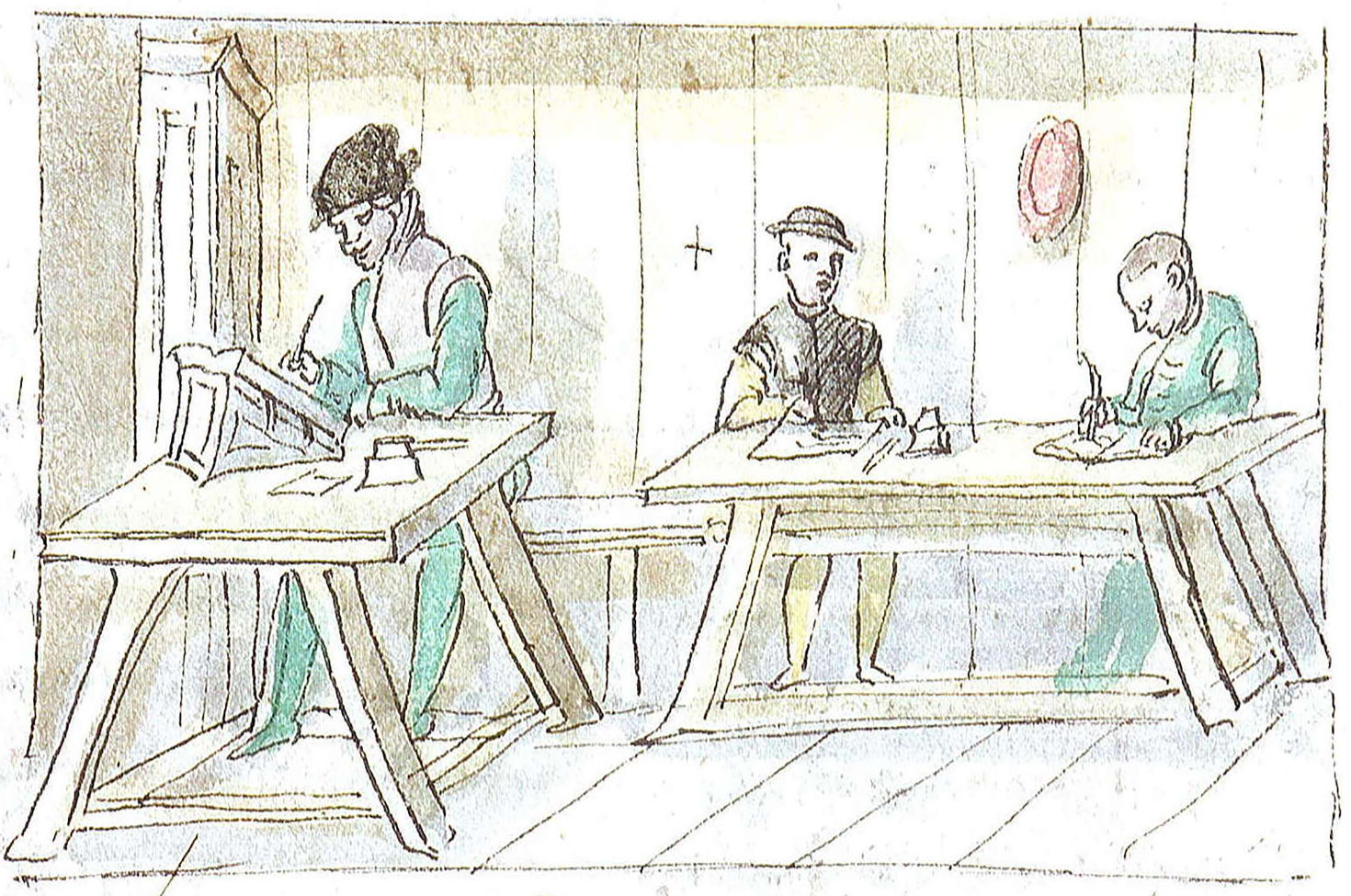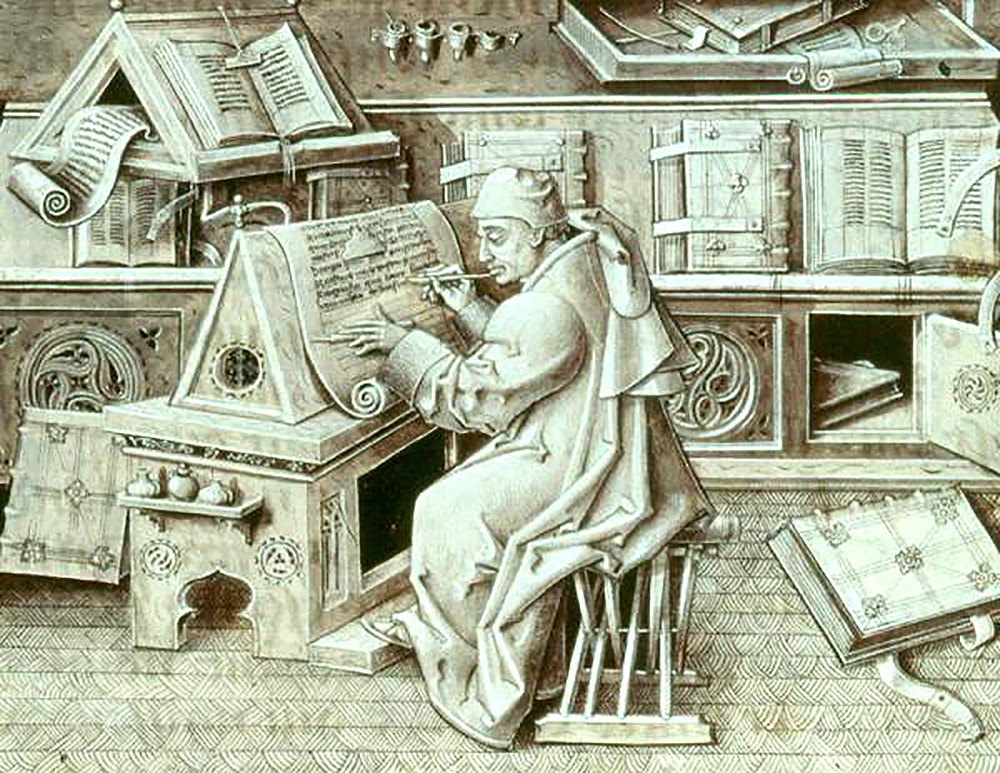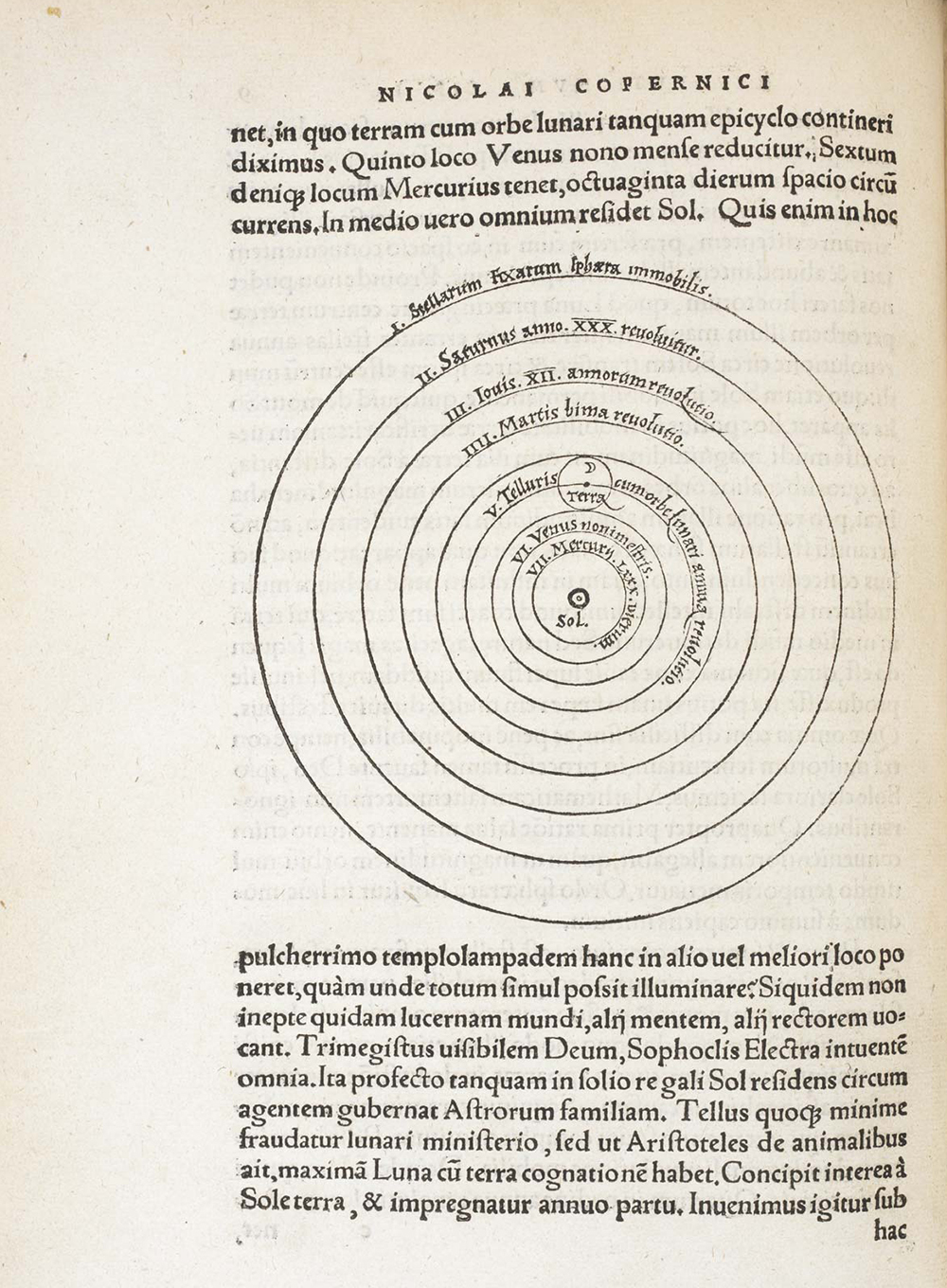
Illustration from the “Schwazer Bergbuch,” 1556. Wikimedia Commons.
Specters haunt the history of publishing and of humanistic scholarship in early modern Europe: lean, shabby ghosts. Correctors, as they were usually called, prepared manuscripts for the press, read proofs, and often added original material of their own. They were everywhere in the world of print, and many early modern humanists—including those whose names remain familiar—either praised or denigrated them and their work.
What, then, did correctors and readers do? The account books of some of the great firms survive, and they provide firsthand evidence. The surviving ledger of the Froben and Episcopius firms, for example, records the wages paid to employees from 1557 to 1564. Each list of employees begins with a corrector or castigator: clear evidence that these learned employees, whose names appeared before those of the compositors and pressmen, enjoyed a certain status, which was higher than that of those who worked with their hands. Each list also includes a lector, whose pay is usually half that of the corrector or less. Sometimes the document states that a given corrector or reader received payment for other activities as well. In March 1560, for example, the lector Leodegarius Grymaldus received payment both for reading and for two other named tasks: making an index and correcting a French translation of Agricola’s work on metals. In March 1563 Bartholomaeus Varolle was paid for correcting but also for preparing the exemplar, or copy, of a thirteenth-century legal text, Guillaume Durand’s Speculum iuris, and for drawing up an index for the work.
Correctors did many other things as well. They corrected authors’ copy as well as proofs. They identified and mended typographical and other errors, to the best of their ability. They divided texts into sections and drew up aids to readers: title pages, tables of contents, chapter headings, and indexes. Some correctors composed texts as well as paratexts, serving as what might now be called content providers.
At times, correctors acted as expert intermediaries between an author and his publisher. The corrector seems to represent a new social type: a phenomenon brought into the world by printing and a native-born son of the new city of books that printing created. It seems obvious that the new art created new tasks. The printer confronted many rivals in the marketplace. He or she had to show that a particular product was superior to those of rivals. One way to do so—as printers rapidly decided—was to emphasize, in the colophon or, later, on the title page, that learned men had corrected the text. In Italy and Germany alike, books printed in the fifteenth century promised their readers not just texts but texts “diligently emended,” “vigilantly emended and revised,” or “most diligently and accurately revised” by particular scholars. Hiring someone to correct a text—or claiming to have done so, as many printers did even though they had not—represented a rational and effective way to claim a larger market share.
One of the most striking facts about correctors was, and is, depressing: for all the utility of what they did, they usually found themselves the objects less of gratitude than of anger, pity, or derision. As early as 1534, when Viglius Zuichemus described Hieronymus Froben’s printing shop, he mentioned the chief corrector there, Sigismund Gelenius, only to say how much he regretted seeing him employed in this capacity. Gelenius, he explained, was “an extraordinarily learned man, and worthy of far better things.” Pretty much everyone agreed. Jeremiah Hornschuch, the proud corrector and author of a textbook on the craft of correcting, admitted that he himself had taken up the trade to avoid the worse one of a tutor, and that most of his colleagues, if they could, “would be off like a shot from this sweatshop, to earn their living by their intelligence and learning, not their hands.”
Correctors had every reason to feel ill used. Their pay was modest: lower than that of the best-paid compositors and pressmen.

The Concordia, an archival document that records the correctors’ agreement in 1664 to hold a yearly feast, also records the whispers, if not the cries, that passed among the correctors when they met to exchange gossip: “I, Philip Jac. Noyens often heard from others, and the venerable De Kleyn heard from Master Vanderweyden, and Hieronymus de Bravio heard from Vanderweyden as well that the correctors used to receive a rise in salary when they had been here for two years. Noyens and the aforesaid De Kleyn also heard this often.” Other notes recalled the names of colleagues wrongfully dismissed—and of still others who had managed to leave for a benefice rather than spend thirty or forty years correcting. The learned corrector, in other words, suffered what sometimes seems to be the quintessential fate of humanists: his classical education endowed him with discriminating tastes but qualified him only to be a poor devil of letters, neither better paid nor more secure in his employment than the inky-handed men of toil who sweated beside him.
Even more grating, probably, was the fact that the corrector’s cultural and social status was as shaky as his financial standing. Many correctors were educated men who lacked the means, the health, or the temperament to get ahead in a profession. But some were artisans. The corrector Theodor Poelman worked, apparently, in what he liked to call the “combined study and fuller’s shop” (musognapheum) from which he signed one of his prefaces, as he said farewell to his reader (“Farewell, then, fuller,” wrote Joseph Scaliger in the margin of his copy). Bartholomaeus Varolle, who in 1563 prepared copy, corrected proofs, and drew up indexes for Froben, was a compositor by training and went back to that better-paid trade when he had the chance. Some of Christophe Plantin’s compositors also corrected proofs for pay. This was a natural extension of their work. Compositors regularly corrected the first or “foul” proof of the texts that they themselves had set. Ordinarily, these swarmed with literal and technical errors and were not meant for the eye of the author or anyone else outside the printing house. Moving to correction in the fuller sense required only an extension of skills that the compositors had already begun to develop. To the corrector, however, such a move was obviously threatening: it meant that the culture in which he took a frail but vital pride no longer set him off, as a “theoretical” worker, from the rude mechanicals.
Considering the practices of correction—like reading all the letters of a great scholar—can yield a new narrative. In 1543 the cunning Nuremberg printer Joannes Petreius brought out Copernicus’ De revolutionibus. The author, far away and ill, could not see the book through the press. Instead, copy was prepared and proofs were read by men experienced with publishers and printing: Georg Joachim Rheticus, who, like many correctors, acted as an agent for Petreius, hunting new authors and manuscripts, and Andreas Osiander. They did not leave the work unchanged. After the holograph of Copernicus’ work came to light in the nineteenth century, philologists noticed that the Petreius edition deviated from it in hundreds of details. Naturally, they restored the text to what Copernicus himself had written. What they failed to notice was that not only the changes in the text proper but a large number of further ones, some proposed in an errata sheet that accompanies some copies of the work and some made in pen in Petreius’ shop, were actually improvements: a point that is relatively easy to establish in the case of a technical work. Copernicus himself must have made many of these changes in an intermediate text that served as printer’s copy and that no longer survives. Others were the result of—as should by now be obvious—correction.
Osiander made one especially radical change, one that has long been infamous. Copernicus believed that he had discovered the truth about the universe, and presented his work as an account of the real world. That claim made his book a direct and radical challenge to the entire structure of natural philosophy, as well as astronomy. Osiander, accordingly, added an anonymous preface to the work, which was addressed to the reader. Here he dialed down the book’s radicalism by claiming that Copernicus had presented his theory not as the truth but only as a hypothesis meant to stimulate discussion. From 1543 to the present, Osiander’s maneuver has infuriated admirers of Copernicus. Rheticus threatened to assault him—and did take him and Petreius to court, unsuccessfully. At the end of the sixteenth and the beginning of the seventeenth centuries, Johann Kepler, Willebrord Snell, and others sorted out the story of how the preface was added: notes in their copies of the text record their indignation. They were right to argue that Osiander had gone against Copernicus’ manifest intentions.

Yet Osiander’s decision also helped to keep Copernicus’s book in circulation. De revolutionibus began attracting sharp criticism as soon as it appeared, and some censors tried to suppress it, or at least to slow its circulation. But it never became the object of a serious campaign of repression, except to some extent in Iberia. As Owen Gingerich has shown by the simple but vital expedient of examining the dozens of preserved copies, the book not only circulated but also attracted readers, who filled the margins with marginalia and made Copernicus’ work a standard text. By the end of the sixteenth century, accordingly, the Copernican genie was out of the box, and no imaginable act of repression—even the attack on Galileo—could put it back.
Seen on its own, Osiander’s act looks outrageous. Even seen in the context of Renaissance methods of correction, it still seems problematic—the act of a little man imposing his own caution on a greater one. But it also seems a prudent and ingenious effort to practice the corrector’s trade—and one that had many counterparts in the sixteenth- and seventeenth-century worlds of erudition. The correctors were figures in a landscape that is now disappearing: one in which authors expected their printers—or their scribes—to improve the work they handed in. In this world many writers envisioned their work as collaborative rather than individual. For centuries, correctors served as the intermediary between writers and readers. They were the distant forefathers not only of the modern philologist but also of the modern editor, who has done so much to shape the work of important writers. Many powerful threads of continuity run through the millennial history of authorship and editing. The consequences of these facts for the history of scholarship—the history of scholarly editing—still await full investigation. But one point is clear. Every time authors become enraged at copy editors, professors, editors, or agents—and every time editors complain that authors do not appreciate their work—they are replaying a scene that is deeply embedded in the classical tradition.
Excerpt adapted from Inky Fingers: The Making of Books in Early Modern Europe by Anthony Grafton, published by Harvard University Press. Copyright © 2020 by the President and Fellows of Harvard College. Used by permission. All rights reserved.
